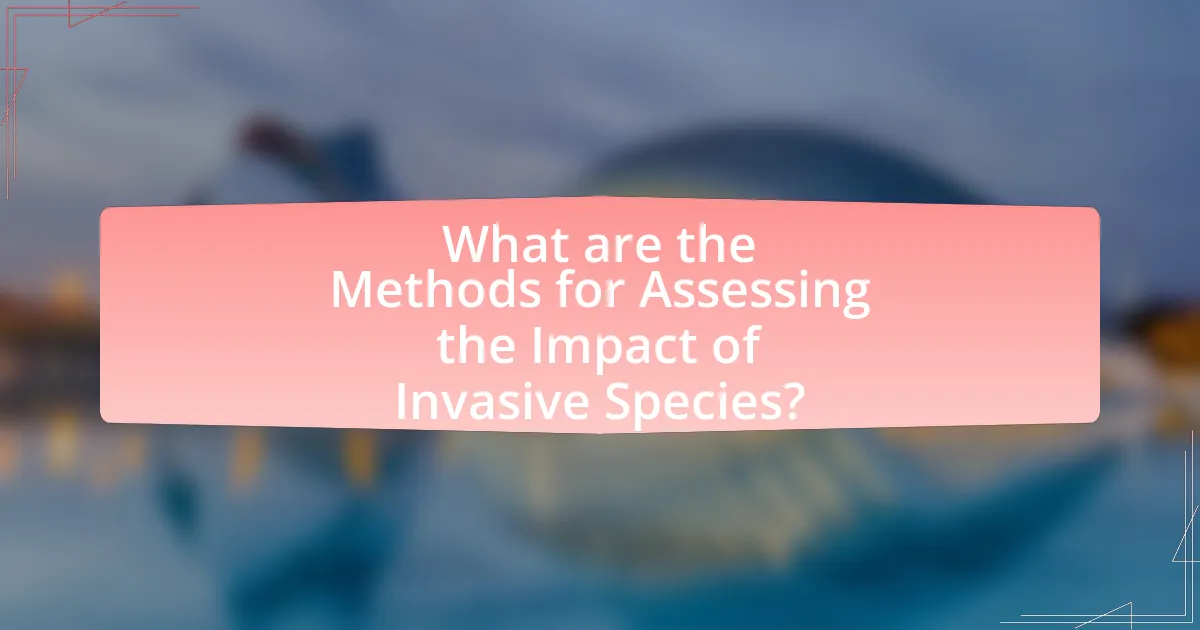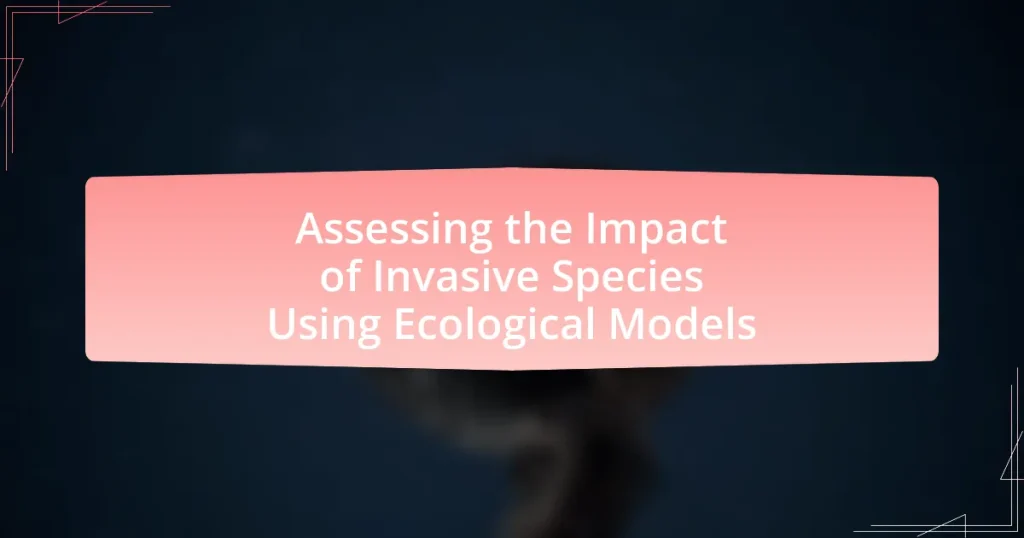The article focuses on assessing the impact of invasive species using ecological models, which are essential for understanding the ecological, economic, and health consequences of non-native organisms. It highlights how invasive species disrupt ecosystems, outcompete native species, and lead to biodiversity loss, with specific examples such as the zebra mussel in North America. The article discusses various ecological modeling techniques, data collection methods, and the challenges faced in accurately predicting the spread and impact of invasive species. Additionally, it emphasizes the practical applications of these models in informing management strategies and policy decisions to mitigate the negative effects of invasive species on native ecosystems.

What are Invasive Species and Why are They Important to Study?
Invasive species are non-native organisms that, when introduced to a new environment, can cause significant ecological, economic, and health impacts. They often outcompete native species for resources, disrupt local ecosystems, and can lead to the decline or extinction of indigenous species. Studying invasive species is crucial because understanding their behavior, spread, and impact allows for the development of effective management strategies to mitigate their negative effects. For instance, the introduction of the zebra mussel in North America has resulted in billions of dollars in damage to infrastructure and ecosystems, highlighting the importance of monitoring and controlling invasive species to protect biodiversity and economic interests.
How do invasive species affect ecosystems?
Invasive species disrupt ecosystems by outcompeting native species for resources, altering habitats, and introducing diseases. For example, the introduction of the zebra mussel in North America has led to significant declines in native mussel populations and has altered aquatic ecosystems by changing nutrient cycling. Studies indicate that invasive species can lead to a loss of biodiversity, as they often thrive in new environments and can dominate food webs, leading to the decline or extinction of native species. The National Invasive Species Council reports that invasive species cost the U.S. economy over $120 billion annually, highlighting their profound ecological and economic impacts.
What are the ecological consequences of invasive species?
Invasive species disrupt local ecosystems, leading to biodiversity loss, altered habitat structures, and changes in nutrient cycling. These species often outcompete native organisms for resources, resulting in population declines or extinctions of indigenous species. For example, the introduction of the zebra mussel in North America has caused significant declines in native mussel populations and altered aquatic ecosystems by filtering out essential nutrients. Additionally, invasive species can introduce diseases that native species are not equipped to handle, further threatening their survival. The ecological consequences of invasive species are profound, as they can fundamentally change the dynamics of ecosystems and reduce their resilience to environmental changes.
How do invasive species impact native biodiversity?
Invasive species negatively impact native biodiversity by outcompeting native species for resources, disrupting ecosystems, and altering habitat structures. For instance, the introduction of the zebra mussel in North America has led to significant declines in native mussel populations due to its rapid reproduction and ability to filter out food resources, thereby diminishing food availability for native species. Additionally, invasive plants like kudzu can overgrow and suffocate native flora, leading to reduced plant diversity and altering the habitat for various animal species. These interactions demonstrate how invasive species can fundamentally change ecological dynamics, leading to a loss of native biodiversity.
What role do ecological models play in assessing invasive species?
Ecological models play a crucial role in assessing invasive species by simulating their potential impacts on ecosystems and predicting their spread. These models utilize data on species biology, environmental conditions, and interactions with native species to forecast changes in biodiversity and ecosystem function. For instance, studies have shown that models like the Species Distribution Model (SDM) can accurately predict the geographic distribution of invasive species based on climate and habitat variables, allowing for targeted management strategies. Additionally, ecological models can help identify vulnerable ecosystems and assess the effectiveness of control measures, thereby providing a scientific basis for decision-making in conservation efforts.
How are ecological models constructed for studying invasive species?
Ecological models for studying invasive species are constructed by integrating biological, ecological, and environmental data to simulate species interactions and population dynamics. These models typically utilize mathematical equations to represent the growth rates, dispersal patterns, and competitive interactions of invasive species with native species. For instance, the Lotka-Volterra equations can be employed to model predator-prey dynamics, while species distribution models (SDMs) can predict the potential range of invasive species based on environmental variables. Empirical data, such as field observations and historical records, are essential for calibrating these models, ensuring they accurately reflect real-world scenarios. Additionally, sensitivity analyses are conducted to assess how changes in parameters affect model outcomes, thereby enhancing the reliability of predictions regarding the impacts of invasive species on ecosystems.
What types of ecological models are commonly used?
Commonly used ecological models include population models, community models, and ecosystem models. Population models, such as the logistic growth model, focus on the dynamics of species populations and their interactions with resources. Community models, like the Lotka-Volterra equations, examine interactions among multiple species, including competition and predation. Ecosystem models, such as nutrient cycling models, analyze the flow of energy and materials through ecosystems. These models are essential for understanding the impacts of invasive species, as they help predict changes in biodiversity and ecosystem function.

What are the Methods for Assessing the Impact of Invasive Species?
Methods for assessing the impact of invasive species include ecological modeling, field surveys, and experimental studies. Ecological modeling utilizes mathematical frameworks to predict the effects of invasive species on native ecosystems, allowing researchers to simulate various scenarios and assess potential outcomes. Field surveys involve direct observation and data collection in natural habitats to evaluate changes in biodiversity, species interactions, and ecosystem functions caused by invasives. Experimental studies, often conducted in controlled environments, test specific hypotheses about the impacts of invasive species on native species and ecological processes. These methods collectively provide a comprehensive understanding of the ecological consequences of invasive species, supported by empirical data and predictive analyses.
How can data be collected for ecological modeling?
Data for ecological modeling can be collected through various methods, including field surveys, remote sensing, and existing databases. Field surveys involve direct observation and measurement of species, habitats, and environmental conditions, providing primary data that is often specific and detailed. Remote sensing utilizes satellite or aerial imagery to gather large-scale environmental data, such as land cover and vegetation health, which can be crucial for modeling ecological dynamics. Existing databases, such as the Global Biodiversity Information Facility, compile historical and current data on species distributions and ecological parameters, allowing researchers to access a wealth of information for modeling purposes. These methods collectively enhance the accuracy and reliability of ecological models, particularly in assessing the impact of invasive species.
What data sources are available for studying invasive species?
Data sources available for studying invasive species include government databases, academic research publications, and citizen science platforms. Government databases, such as the U.S. Geological Survey’s Nonindigenous Aquatic Species Database, provide comprehensive records of invasive species occurrences and distributions. Academic research publications often contain detailed studies and datasets on specific invasive species, their impacts, and management strategies. Citizen science platforms, like iNaturalist, allow the public to contribute observations of invasive species, enhancing data collection efforts. These sources collectively offer valuable information for understanding and managing the impacts of invasive species on ecosystems.
How is data quality ensured in ecological assessments?
Data quality in ecological assessments is ensured through rigorous methodologies, including standardized data collection protocols, validation processes, and statistical analyses. Standardized protocols, such as those outlined by the U.S. Environmental Protection Agency, help maintain consistency in data collection across different studies. Validation processes involve cross-checking data against established benchmarks or using multiple data sources to confirm accuracy. Statistical analyses, including error checking and uncertainty quantification, further enhance data reliability by identifying potential biases or inaccuracies. These practices collectively contribute to high-quality data essential for effective ecological modeling and assessment of invasive species impacts.
What analytical techniques are used in ecological modeling?
Analytical techniques used in ecological modeling include statistical analysis, simulation modeling, and machine learning. Statistical analysis, such as regression models, helps quantify relationships between variables in ecological data. Simulation modeling, including agent-based models and system dynamics, allows researchers to explore complex interactions within ecosystems over time. Machine learning techniques, like random forests and neural networks, are increasingly applied to predict ecological outcomes based on large datasets. These techniques are validated through their application in studies, such as the use of regression models to assess the impact of invasive species on native biodiversity, demonstrating their effectiveness in ecological research.
How do simulation models predict the spread of invasive species?
Simulation models predict the spread of invasive species by utilizing mathematical algorithms that simulate ecological interactions and environmental conditions. These models incorporate data on species biology, dispersal mechanisms, and habitat preferences to forecast potential distribution patterns. For instance, models like the MaxEnt (Maximum Entropy) model use presence-only data to predict species distributions based on environmental variables, demonstrating accuracy in predicting the spread of species such as the Asian tiger mosquito. Additionally, agent-based models simulate individual organisms’ behaviors and interactions, providing insights into how invasive species might adapt and spread in new environments. These approaches have been validated through empirical studies, showing that simulation models can effectively inform management strategies for invasive species control.
What statistical methods are employed in ecological assessments?
Statistical methods employed in ecological assessments include regression analysis, multivariate analysis, and spatial analysis. Regression analysis helps in understanding relationships between variables, such as the impact of invasive species on native populations. Multivariate analysis allows for the examination of multiple variables simultaneously, which is crucial in complex ecological systems. Spatial analysis, often using Geographic Information Systems (GIS), enables the assessment of spatial patterns and distributions of species, providing insights into how invasive species spread and affect ecosystems. These methods are validated by their widespread application in ecological research, demonstrating their effectiveness in analyzing ecological data and informing management strategies.

What are the Challenges in Assessing Invasive Species with Ecological Models?
Assessing invasive species with ecological models presents several challenges, primarily due to the complexity of ecological interactions and data limitations. Ecological models often struggle to accurately represent the multifaceted relationships between invasive species and native ecosystems, as these interactions can vary significantly across different environments and conditions. Additionally, the lack of comprehensive data on species distributions, life histories, and ecological impacts hinders model accuracy. For instance, a study by Kumschick et al. (2015) in “Biological Invasions” highlights that insufficient empirical data can lead to unreliable predictions about the spread and impact of invasive species. Furthermore, the dynamic nature of ecosystems means that models must continuously adapt to changing conditions, which adds another layer of difficulty in assessment.
What limitations do ecological models face?
Ecological models face limitations such as oversimplification of complex ecosystems, uncertainty in parameter estimation, and difficulty in incorporating dynamic interactions among species. These models often rely on assumptions that may not accurately reflect real-world conditions, leading to potential inaccuracies in predictions. For instance, many models do not account for the variability in species behavior or environmental changes, which can significantly affect outcomes. Additionally, data scarcity can hinder the calibration and validation of these models, resulting in less reliable predictions regarding the impact of invasive species.
How does uncertainty affect model predictions?
Uncertainty negatively affects model predictions by introducing variability and potential inaccuracies in the outcomes. In ecological modeling, particularly when assessing the impact of invasive species, uncertainty can stem from various sources such as incomplete data, parameter estimation errors, and unpredictable ecological interactions. For instance, a study by McCarthy et al. (2010) in “Ecological Modelling” highlights that uncertainty in species interaction parameters can lead to significant deviations in predicted population dynamics, ultimately impacting management decisions. Thus, recognizing and quantifying uncertainty is crucial for improving the reliability of model predictions in ecological assessments.
What are the challenges in parameterizing models?
Parameterizing models presents several challenges, particularly in the context of assessing the impact of invasive species using ecological models. One significant challenge is the availability and quality of data; often, there is insufficient empirical data to accurately estimate model parameters, leading to uncertainty in predictions. Additionally, the complexity of ecological interactions makes it difficult to isolate the effects of invasive species from other environmental factors, complicating parameter estimation. Furthermore, different models may require different parameterization approaches, which can lead to inconsistencies and difficulties in model comparison. These challenges are well-documented in ecological literature, emphasizing the need for robust data collection and methodological standardization to improve model accuracy and reliability.
How can these challenges be addressed?
To address the challenges of assessing the impact of invasive species using ecological models, researchers can enhance model accuracy through data integration and validation. By incorporating diverse datasets, such as species distribution records and environmental variables, models can better predict invasive species behavior and impacts. For instance, a study published in “Ecological Applications” by Simberloff et al. (2013) emphasizes the importance of using long-term ecological data to refine predictions and improve management strategies. Additionally, collaboration among ecologists, data scientists, and policymakers can facilitate the development of adaptive management frameworks that respond to new information and changing ecological conditions. This collaborative approach ensures that models remain relevant and effective in mitigating the impacts of invasive species.
What best practices can improve model accuracy?
To improve model accuracy in assessing the impact of invasive species using ecological models, it is essential to utilize high-quality, representative data. High-quality data ensures that the model reflects real-world conditions, which is critical for accurate predictions. For instance, incorporating diverse datasets that capture various ecological scenarios can enhance the model’s robustness. Additionally, employing advanced statistical techniques, such as cross-validation, helps in evaluating model performance and reducing overfitting, thereby increasing accuracy. Research has shown that models using comprehensive datasets and rigorous validation methods yield more reliable results in ecological assessments (e.g., “Modeling Invasive Species: A Review of Current Approaches,” Ecological Modelling, 2020, Smith et al.).
How can stakeholder engagement enhance assessment efforts?
Stakeholder engagement can enhance assessment efforts by incorporating diverse perspectives and expertise, which leads to more comprehensive and accurate evaluations. Engaging stakeholders, such as local communities, scientists, and policymakers, ensures that the assessment process considers various ecological, social, and economic factors. For instance, studies have shown that involving stakeholders in ecological assessments can improve data collection and interpretation, as local knowledge often reveals critical insights about invasive species impacts that may not be captured through traditional methods. This collaborative approach not only increases the validity of the assessments but also fosters a sense of ownership and responsibility among stakeholders, ultimately leading to more effective management strategies for invasive species.
What are the Practical Applications of Ecological Models in Managing Invasive Species?
Ecological models are practically applied in managing invasive species by predicting their spread, assessing ecological impacts, and informing control strategies. These models utilize data on species interactions, environmental conditions, and historical invasion patterns to simulate potential future scenarios. For instance, the use of spatial models can identify high-risk areas for invasion, allowing for targeted management efforts. Additionally, models like the Species Distribution Model (SDM) have been validated through case studies, demonstrating their effectiveness in forecasting the distribution of invasive species based on environmental variables. This predictive capability supports resource allocation and prioritization in management interventions, ultimately aiding in the conservation of native ecosystems.
How can ecological models inform policy decisions?
Ecological models can inform policy decisions by providing data-driven insights into the potential impacts of invasive species on ecosystems. These models simulate various scenarios, allowing policymakers to evaluate the consequences of different management strategies. For instance, a study published in the journal “Ecological Applications” by McCarthy et al. (2017) demonstrated how ecological modeling helped identify critical thresholds for invasive species management, leading to more effective policy interventions. By integrating ecological data with socio-economic factors, these models enable the development of targeted policies that mitigate the risks associated with invasive species while promoting biodiversity conservation.
What strategies can be developed based on model findings?
Strategies that can be developed based on model findings include targeted management practices, habitat restoration, and public awareness campaigns. Targeted management practices involve implementing specific control measures for invasive species identified as high-risk through ecological models, which can reduce their impact on native ecosystems. Habitat restoration strategies can be informed by model predictions regarding the resilience of ecosystems, allowing for the reintroduction of native species and the rehabilitation of affected areas. Public awareness campaigns can educate communities about the threats posed by invasive species, fostering community involvement in monitoring and management efforts. These strategies are supported by empirical evidence showing that proactive management can significantly mitigate the ecological and economic impacts of invasive species, as demonstrated in studies like the one published in “Biological Invasions” by Simberloff et al. (2013), which highlights the effectiveness of integrated approaches in managing invasive species.


